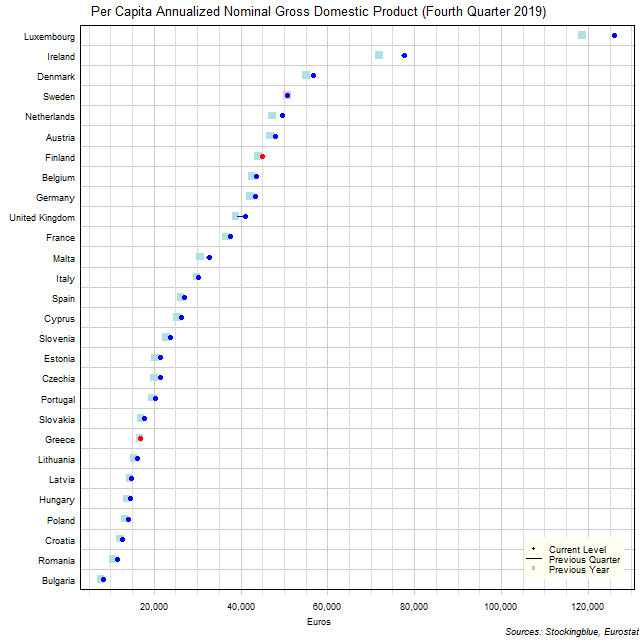
The chart above shows the per capita annualized nominal gross domestic product (GDP) in each EU state as of the fourth quarter of 2019 in euros, the change from the previous quarter, and the GDP one year prior. Sweden, Finland, and Greece were the only states to see a drop in per capita GDP either over the previous quarter or over the previous year.
Findings
- The difference between the state with the largest per capita GDP, Luxembourg, and the state with the smallest, Bulgaria, is €117,644.20 (up from €117,325.05 last quarter and up from €110,837.07 last year). Luxembourg and Bulgaria had the largest and smallest per capita GDP respectively both last quarter and last year.
- Luxembourg has 15.05 times the per capita GDP that Bulgaria does. The ratio of largest per capita GDP to smallest per capita GDP was down from 15.40 last quarter and down from 15.27 last year.
- The median per capita GDP in the 28 EU states is €26,691.80 (up from €26,470.35 last quarter and up from €25,750.44 last year) and the mean €33,897.71 (up from €33,566.99 the previous quarter and up from €32,503.32 last year).
- Twenty-six states saw their per capita GDP rise in current euros from the previous quarter while two states saw their per capita GDP drop.
- Twenty-seven states saw their per capita GDP rise in current euros from last year while one state saw its per capita GDP drop.
Caveats
- GDP data is from the fourth quarter of 2019, the third quarter of 2019, and the fourth quarter of 2018.
- Census data is from 2011.
- The data is seasonally adjusted in current euros.
- The data is annualized by multiplying the quarterly figure by four.
- All figures are rounded to the nearest hundredth.
Details
In absolute terms, Greece saw the largest decrease over the previous quarter with a drop of €142.83. The United Kingdom had the largest growth with a gain of €1,928.40. Year over year, Sweden had the largest decrease with a drop of €61.31 while Luxembourg had the greatest increase with a gain of €7,413.26.
In relative terms, Greece had the largest decrease over the previous quarter with a 0.85% drop in per capita GDP while the United Kingdom had the greatest increase with a 4.92% rise in per capita GDP. Year over year, Sweden had the largest decrease with a 0.12% drop in per capita GDP while Romania had the largest growth with a 9.27% rise in per capita GDP.
The number of states with a per capita GDP of over €75,000 was one last year, two the previous quarter, and two this past quarter. Conversely, the number of states with a per capita GDP of less than €20,000 was ten last year, nine the previous quarter, and nine this past quarter.
Not a single state overtook another in the past quarter or over the year.
Data
| State | Fourth Quarter 2018 | Third Quarter 2019 | Fourth Quarter 2019 |
|---|---|---|---|
| Austria | 46,775.06 | 47,711.02 | 48,004.22 |
| Belgium | 42,510.63 | 43,161.5 | 43,669.1 |
| Bulgaria | 7,768.74 | 8,146.19 | 8,374.87 |
| Croatia | 12,190.62 | 12,672.59 | 12,706.25 |
| Cyprus | 25,368 | 26,208.25 | 26,323.04 |
| Czechia | 20,101.67 | 21,078.68 | 21,510.61 |
| Denmark | 55,077.38 | 56,294.36 | 56,614.32 |
| Estonia | 20,325.8 | 21,217.45 | 21,518.88 |
| Finland | 43,961.28 | 44,903.37 | 44,878.81 |
| France | 36,594.93 | 37,377.84 | 37,488.76 |
| Germany | 42,196.77 | 42,981.99 | 43,336.21 |
| Greece | 16,714.18 | 16,859.35 | 16,716.52 |
| Hungary | 13,725.24 | 14,434.49 | 14,539.84 |
| Ireland | 71,866.85 | 76,904.74 | 77,600.1 |
| Italy | 29,806.58 | 30,164.28 | 30,200.9 |
| Latvia | 14,442.07 | 14,762.14 | 14,780.26 |
| Lithuania | 15,355.63 | 15,926.16 | 16,250.21 |
| Luxembourg | 118,605.81 | 125,471.24 | 126,019.07 |
| Malta | 30,635.99 | 32,113.62 | 32,725.69 |
| Netherlands | 47,298.22 | 49,005.32 | 49,502.35 |
| Poland | 13,222.35 | 13,907.14 | 14,172.91 |
| Portugal | 19,563.89 | 20,153.22 | 20,322.11 |
| Romania | 10,468.55 | 11,118.3 | 11,439.34 |
| Slovakia | 16,948.75 | 17,516.36 | 17,769.6 |
| Slovenia | 22,878.87 | 23,614.41 | 23,803.46 |
| Spain | 26,132.89 | 26,732.45 | 27,060.56 |
| Sweden | 50,758.65 | 50,257.35 | 50,697.34 |
| United Kingdom | 38,797.67 | 39,182.02 | 41,110.42 |
Sources
Eurostat. 2020. "GDP and Main Components." Accessed April 22, 2020. https://appsso.eurostat.ec.europa.eu/nui/show.do?query=BOOKMARK_DS-406779_QID_265259FB_UID_-3F171EB0&layout=TIME,C,X,0;GEO,L,Y,0;UNIT,L,Z,0;S_ADJ,L,Z,1;NA_ITEM,L,Z,2;INDICATORS,C,Z,3;&zSelection=DS-406779UNIT,CP_MEUR;DS-406779INDICATORS,OBS_FLAG;DS-406779S_ADJ,SCA;DS-406779NA_ITEM,B1GQ;&rankName1=UNIT_1_2_-1_2&rankName2=INDICATORS_1_2_-1_2&rankName3=NA-ITEM_1_2_-1_2&rankName4=S-ADJ_1_2_-1_2&rankName5=TIME_1_0_0_0&rankName6=GEO_1_2_0_1&sortC=ASC_-1_FIRST&rStp=&cStp=&rDCh=&cDCh=&rDM=true&cDM=true&footnes=false&empty=false&wai=false&time_mode=NONE&time_most_recent=false&lang=EN&cfo=%23%23%23%2C%23%23%23.%23%23%23.
Eurostat. 2017. "Population on 1 January by Age Groups and Sex - Functional Urban Areas." Accessed December 11, 2017. http://appsso.eurostat.ec.europa.eu/nui/show.do?dataset=urb_lpop1&lang=en.